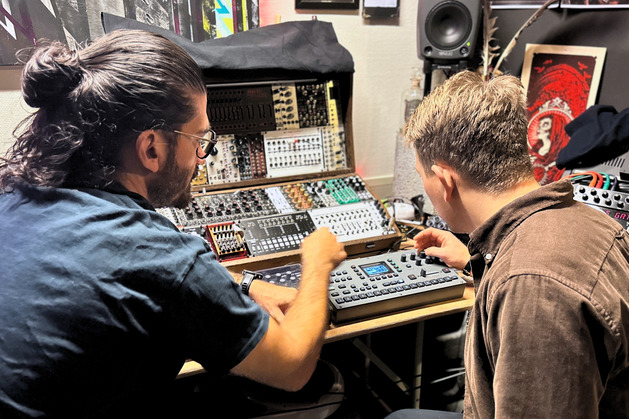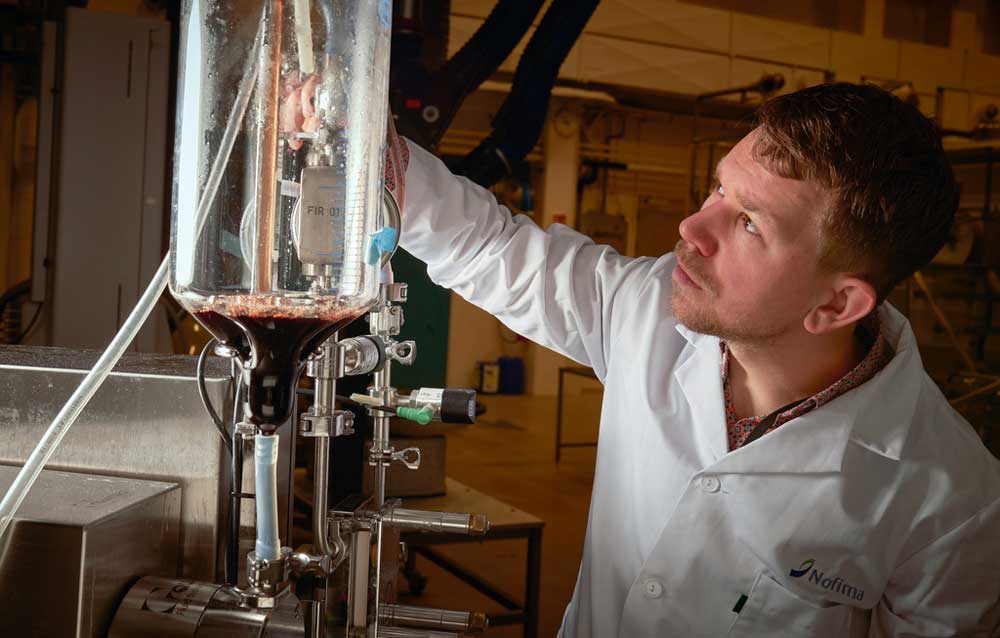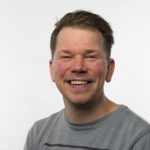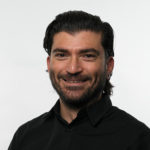SoundScape – a landscape of sound from food research

Runar and Themis turn datasets from food research into electronic ‘music’. This is how the two Nofima scientists hope to arouse interest in science among young people.
Listen: The sound of proteins
This is the sound of proteins from lumpfish. They become smaller in size the longer the soundtrack goes.
At Insomnia in Tromsø in October – an international festival for new electronic music and technoculture – you can hear the results of the SoundScape research project.
“It is one way of making more people aware of what research can actually be, involving completely new methods and arenas for research dissemination. There are many people who have never read a research article and who may also be sceptical about an institute like ours, which creates solutions and gathers knowledge to help society, including the future food industry,” says Nofima scientist Themis Altintzoglou.
“As a result, we hope our research reaches out to people who it would otherwise have been almost impossible to get interested in research. Socioeconomically speaking, if just one 14-year-old becomes curious and wants to study a research programme at upper secondary school, our project pays off,” adds colleague Runar Gjerp Solstad.
NASA and astrophysics
NASA
NASA collects cosmic sound with the Hubble Space Telescope and uses what it calls soundification in communications to generate interest in what is happening in space.
Listen to more sounds at science.nasa.gov
“TED-talk”
In a TED talk, blind astrophysicist Wanda Diaz Merced tells how she transformed datasets into sound so that she could understand them and continue with the research she loved after she lost her sight.
Using these as inspiration, bioengineer Runar Gjerp Solstad and consumer scientist Themis Altintzoglou turn research data into music.
Way back in his student days, Runar saw the blind astrophysicist give a lecture – and he was mesmerised.
“Unbelievably interesting. I thought it had to be transferable to the same thing we were doing. It is the same type of datasets that we use, where the information is spread in three dimensions – time, intensity and wavelength. When I started working at Nofima, I came into contact with Themis, who had been thinking exactly the same as me, and who had even ‘played around’ with the technology that makes it possible,” says Runar enthusiastically.
So, when two people who have the ability to think ‘outside the box’ sit at the same table during lunch, maybe not sweet music, but at least some kind of music can quickly arise. Themis found that his colleague Runar didn’t have that much knowledge about music, but he had a great interest in creative research dissemination.
“My interest was piqued when I found software that could make sound from pictures of birds. The brighter the birds, the higher the tones. I thought it might be transferable to the spectroscopic images colleagues worked with in their research, but it didn’t go very well. Putting it diplomatically, it didn’t sound that nice, so there was nothing to take further. The project was terminated,” says Themis.

Completely different directions than expected

He has played in bands since he was 16 years old, and has been composing his own music for the last seven or eight years. What he calls electronic background music has also become film music – including in ‘Sound The Alarm’, which was screened at the Tromsø International Film Festival (TIFF) in 2023 and can now be found on NRK’s website.
So, when Runar Gjerp Solstad presented his ‘crazy ideas’, Themis was also ready to once again use sound in research.
“I have always been extremely fond of projects that are innovative and that move in completely different directions than expected. What happens if we do this instead of that, choose a new direction instead of the expected and safe option – which everyone thinks we should. We want to create an understanding of why creativity is such an important part of our job. It is easy to forget about being creative in your research when you just have to deliver what has been planned and tick the right boxes. Therefore, I think we have worked much more than what is expected in this extremely creative project”, says Runar.
However, no matter how creative you are, how eager you are and how exciting the research project is: Money is needed to make it happen. And making music out of datasets has proven overly creative for most research funders. This is despite the fact that the dataset’s foundation is research on the utilisation of rest raw materials and making full use of food resources, a direction that is constantly highlighted as being extremely important.
“We have applied several times and to several places for project funding. The last time was via BlueBio ERA-NET where we are participants with our own research project called BlueCC. When the announcement came at the beginning of the year with a invitation to think ‘outside the box’, we got excited. We were at it once again. The Research Council of Norway funded our project and gave it NOK 218,000. That is relatively little money as far as research projects go, but we really want to do this, so that’s what we’ve got to work with. I guess you could say that we have done quite a bit of unpaid intern work,” says Runar Gjerp Solstad
Time, intensity and wavelength of light
In BlueCC, the scientists have collected lots of data – and have many datasets. They were ready to get started.
“Our datasets have data in three dimensions: Time, intensity and wavelength of light – a bit like a map, which also shows data in three dimensions: height, length and width. These data points are what we transform into sound: Time remains as time. Intensity becomes volume and light turns into musical keys,” explains the musician among the two.
And the biologist adds:
For example, if we extract collagen protein from fish skin and get purer and purer collagen as we develop the methods, this could affect the soundscape we create because a diversity of proteins will produce a more chaotic soundscape while purer proteins will produce fewer tones. The long-term goal is to be able to use this characteristic to create a more harmonious soundscape the purer the proteins in the dataset are. The two scientists have developed a scientifically rendered soundscape as the project’s delivery, and a slightly more adapted artistic variation, which is edited so that it will be nice to listen to when it is presented at the Insomnia Festival on 21 October.
Listen: The sound of proteins
This is the sound of proteins from lumpfish. They become smaller in size the longer the soundtrack goes.
“We also want to create an NFT creation. It is a kind of data-signed artwork that we take ownership of via blockchain technology. We will have to see how much time and money we have,” says project manager Runar Gjerp Solstad.
Do you expect any debate about the use of tax revenues for such creative research – and dissemination of research?
“Not only do we expect such a debate, we also believe that there should be one, and it is fully understandable in a project that is so outside the box. That said: The Research Council of Norway has allocated funding. We have responded to a call for proposals, but we are ready to take part in a debate if anyone wants to challenge us,” says Runar Gjerp Solstad.
What does society get out of a research project like SoundScape?
“This project has no immediate research ambitions. It is purely a communication project. Perhaps the most valuable thing of all is that this delivery will reach an audience that would otherwise have been virtually impossible to reach”, says Runar.
The two scientists also point to the importance of daring to think in completely new ways. Always being at the forefront of development is the nature of research.
“We want to create things that can be used, thereby creating interest. We want to shatter the notion that research is boring work,” says Themis Altintzoglou.

